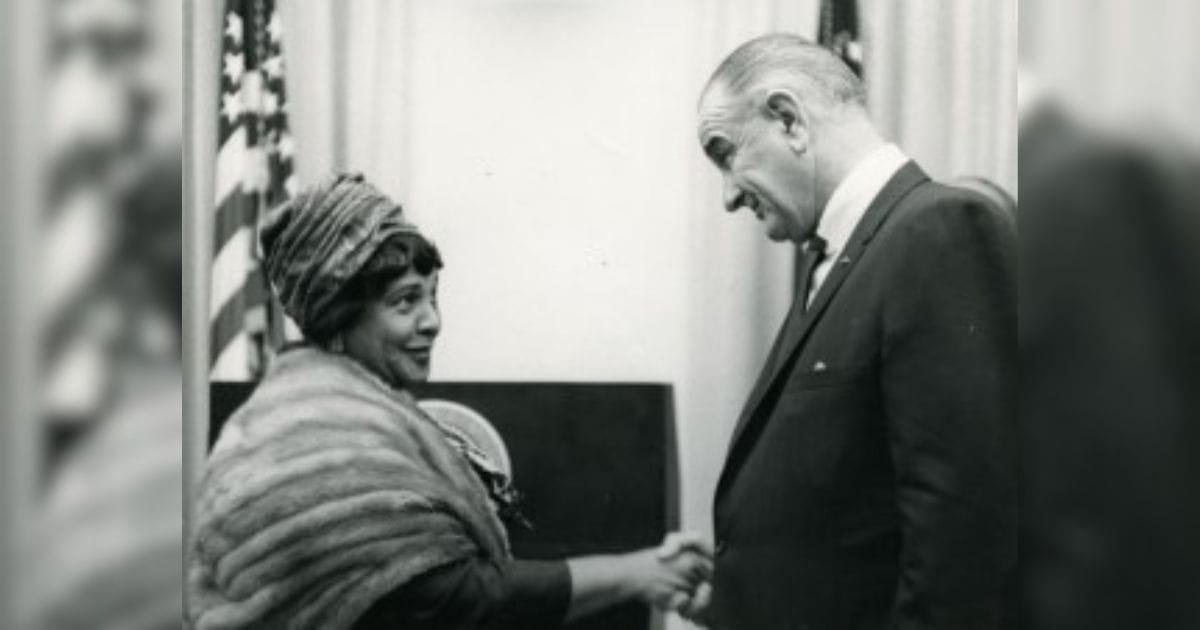Ethel Payne with President Lyndon B. Johnson
As the White House remembers Ethel Payne, nearly $9,000 has been raised for a headstone, to be placed on the pioneering journalist’s grave at Mt. Glenwood Memory Gardens South in Glenwood, Illinois.
Payne died in 1991 in Washington, D.C., where she and journalist Alice Dunnigan made history, after becoming the nation’s first Black female White House correspondents at a time when there were few Black reporters covering America’s highest political office.
The White House recently announced that a lectern in the White House Press Room with Payne’s and Dunnigan’s names on it will honor the women for their historic achievements and contributions as journalists.
Payne, a journalist working for the Chicago Defender’s Washington bureau, was known as “the First Lady of the Black Press.”
In 2022, Payne and Dunnigan were honored at the White House Correspondents Dinner with their names placed on the Lifetime Achievement Award. In 2002, Payne was honored with a U.S. postage stamp, and she is honored as a member of the National Association of Black Journalists Hall of Fame. Lindblom Math and Science Academy, Payne’s alma mater, named its journalism program after her.
Some 33 years after her death, Payne remains buried in an unmarked grave in Mt. Glenwood Memory Gardens South. But a successful fundraising campaign led by historian Tammy Gibson has raised $8,947 to place an elaborate marker on Payne’s grave, located in the cemetery near an old water pump, and several hundred yards from the grave of the Honorable Elijah Muhammad, founder of the Nation of Islam.
With the funds available to order a headstone to honor Payne’s legacy, Gibson is now waiting on Payne’s niece, Sylvia Peters, to visit the cemetery from Knoxville, Tennessee, to verify and confirm her relationship to Payne. Before one can place a marker on a grave, he or she must get approval from a descendant or relative of the deceased, according to Illinois law. Gibson told the Crusader that Peters plans to visit the cemetery later this year.
In 2016, the Crusader published a story about Payne being buried in an unmarked grave at Mt. Glenwood Memory Gardens South. Titled “Gone and Forgotten,” the story detailed Payne’s struggles as a Black White House correspondent working with a predominately white male press pool.
Gibson said in 2021 she was researching the life of Payne and decided to visit her grave at Mt. Glenwood Memory Gardens South, located at 18301 S. Glenwood Thornton Road. When she couldn’t find Payne’s grave, she went to the cemetery office where she was told the plot didn’t have a headstone. That’s when she launched a fundraising campaign to purchase one.
Gibson said the headstone will be a black marble slab that will have Payne’s name and information on her career, and importance in Black history.
She said it will be similar to the one she had placed on the grave of Eugene Williams at Lincoln Cemetery in Blue Island in 2019. Williams was the Black teenager murdered by a white mob when he swam in a segregated portion of the 29th Street Beach in 1919.
“Ethel Payne was a trailblazing journalist who needs to be honored,” Gibson said.
Payne was born in Chicago in 1911. She was raised in a two-story house in the 6200 block of South Throop Street in West Englewood, a neighborhood populated by white residents before the Great Migration.
Down the street, she attended Copernicus Elementary School (now Langford Academy). She also attended Lindblom Math and Science Academy (then Lindblom High School), where she had the same teacher as author Ernest Hemingway. She attended Crane Junior College and Northwestern Medill School of Journalism.
Payne’s father worked as a Pullman porter, and her mother stayed at home to look after their six children. During her childhood, she was a voracious reader, especially the poems of Paul Laurence Dunbar. Payne’s father passed away when she was 12. To make money, her mother opened their home as a boarding house, and became a teacher of Latin.
After working as a library assistant with the Chicago Public Library, in 1948, Payne left Chicago to work as a volunteer in Japan for the Army Special Services club.
When the Korean War began in 1950, she wrote in her journal about the treatment of African American troops. Although President Harry Truman had ordered the military to be integrated, General James McCarthy refused to desegregate the troops. Payne wrote about the segregation of the soldiers, the racial slurs that were used against them, and about the babies that were abandoned as orphans because they were born to Japanese mothers and Black fathers.
Payne showed Korean War reporter Alex Wilson her diary and, after reading a few excerpts, he asked to send her notes to the Chicago Defender. She was offered a full-time position and began writing for the Defender in 1951.
In 1953, Payne moved to Washington, D.C., to take over the one-person bureau as a correspondent. She was one of few Blacks who held credentials with the White House Press Corps.
In the White House Press Room, Payne became known for angering President Dwight D. Eisenhower when she asked him a question about ending segregation in interstate travel.
Payne continued to work to bring more awareness to the Civil Rights Movement. She reported on Rosa Parks and the Montgomery Bus Boycott and the Little Rock Nine at segregated Little Rock Central High School in Little Rock, Arkansas. She interviewed Martin Luther King, Jr., before he made national headlines.
Despite the numerous bylines and global admiration, Payne was often broke and seeking help from donors to pay her bills and fund her trips for assignments. Her struggles are chronicled in a book by noted author James McGrath Morris, “Eye on the Struggle: Ethel Payne, the First Lady of the Black Press.”
Payne did not have any furniture in her apartment when she learned the Nixons planned to attend a party she was hosting, according to McGrath. A manager of the now defunct Hecht’s Department Store shipped her a truckload of furniture and gave her a line of credit.
Though she had little money, Payne had a reputation of being a generous humanitarian and fierce advocate of the Black Press and America’s Black leaders.
On May 28, 1991, she died of a heart attack in her Washington, D.C., apartment. According to McGrath, a devoted friend, Shirley Small-Rougeau, found her unconscious on the floor.
-
Erick Johnsonhttps://chicagocrusader.com/author/erick-johnson/
-
Erick Johnsonhttps://chicagocrusader.com/author/erick-johnson/
-
Erick Johnsonhttps://chicagocrusader.com/author/erick-johnson/
-
Erick Johnsonhttps://chicagocrusader.com/author/erick-johnson/






